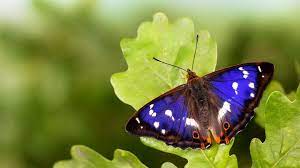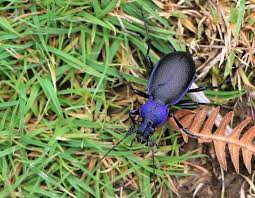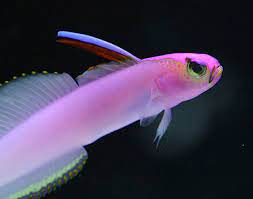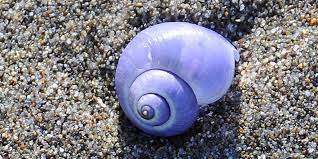Have you ever seen purple animals before? The odds are, you haven’t! It’s not a common color found in nature. Since plants and animals cannot produce pigments for the color, it remains a rarity. Despite its scarcity, purple is often associated with royalty.
Table of Contents
But did you know that purple flowers and animals do exist, although they’re less common? Some animals show off their purple color for various reasons like attracting a mate, warning predators, or protecting themselves from sunlight.
They do this through their exterior interacting with light. If you’re curious to know more, keep reading! Here are ten different purple-colored animals that are sure to leave you in awe.
1. Purple Emperor

The elusive purple emperor butterfly is a majestic creature that can only be found in certain regions of central southern, southeast, and eastern England. With its impressive purple color, it’s often referred to as ‘His Imperial Majesty,’ rightfully earning its name due to its large size and beautiful appearance.
However, not many have had the privilege of seeing one because they tend to stick to temperate regions and avoid the hottest and coolest areas. Its size, which is as big as a bat, and its soaring tendencies above middle-sized trees make it unique compared to other butterflies that tend to flit around.
If you spot a male purple emperor, you’ll notice the rich and iridescent purple hue. This beauty owes its scientific name, “Apatura iris,” to the Greek word “Apatura,” meaning deception, as it is elusive and only shows off its stunning color to the lucky viewer at the right angle. Keep an eye out for this mysterious creature, who is more likely to appear between early July and early August.
2. Purple Starling

When you think of purple animals, you might not immediately think of birds, but it turns out that most of the purple animals in the world are, in fact, birds. One such bird is the purple starling, also known as the purple glossy starling.
This bird is part of the starling family and is easily recognizable thanks to its large size, short tail, and distinctive purple color. But that’s not all that sets this bird apart. The purple starling also boasts a huge yellow-orange eye that really pops against its purple feathers.
You’re most likely to find these birds in flocks in savanna habitats in Africa, though they can also be found in freshwater environments, shrublands, and anthropogenic biomes. While they may be noisy omnivores that eat both plants and animals, they sure are a sight to behold.
3. Violet Ground Beetle

Violet is a mesmerizing color that has always captured our attention. It is darker than purple and is used to describe a range of objects and creatures, including the violet ground beetle. These beetles are fascinating creatures that survive on a diet of slugs and other smaller invertebrates.
They are nocturnal and rest during the day under foliage or stones. The best part about these beetles is that they are widespread and can be found everywhere, from woodlands to farmlands and freshwater streams.
There are two species of the violet ground beetle, and while they may look alike, one is more common than the other. The Carabus violaceus, which favors gardens and meadows, is the more common of the two.
These two beetle species share a striking metallic-purple color around the edges of their fused wings, or elytra, which is undoubtedly eye-catching. However, upon closer inspection, one can see the distinct differences between the elytra of these two species. The Carabus problematicus boasts a more textured appearance, with ridges and dimples that create a three-dimensional effect.
4. Orchid Dottyback

The Orchid Dottyback, also referred to as Fridman’s Dottyback or Purple Dottyback displays a stunning and vibrant purple coloration. These fish, with a maximum size of around 7 cm, are widely found in the Red Sea. Among dottyback species, they are known for their friendly and peaceful nature, as well as their robustness and bold behavior.
Similar to other dottybacks, they exhibit sexual dimorphism, which means they are initially born as females but have the ability to change to males. However, once they undergo this change, they cannot revert to their original sex.
Orchid Dottybacks are frequently kept as pets in aquariums, but caution must be exercised when selecting tank mates. They should not be housed with timid fish, as the dotty backs have a tendency to prey on them. It is recommended to introduce them to the aquarium as the last addition, allowing the existing fish to establish their territories and stand their ground against the dotty back. Nevertheless, their primary diet consists of bristle worms, ornamental shrimps, and fan worms.
These fish prefer to dwell around vertical rocks, though they are not particularly inclined towards living in groups. If one wishes to keep more than one Orchid Dottyback in a tank, providing broken lines of sight is essential to reduce potential territorial conflicts. Additionally, as they are jumpers, it is vital to ensure the tank has a secure lid.
5. Purple Starfish

The purple starfish, also known as the purple sea star or ochre sea star, is a familiar sight along the rocky shorelines of the Pacific Ocean, particularly in areas like Alaska and California. These creatures primarily feed on shellfish, making their homes among rocks in these coastal regions.
Typically, the purple starfish displays a purple coloration, but there are variations that can be orange, yellow, or brown. While most individuals have five arms, some may have three, four, or seven arms. The length of their arms varies between 10 to 25 cm, and they can weigh close to a pound. With their robust bodies covered in numerous spines, they present a bulky appearance.
Interestingly, most sea creatures cannot tolerate high levels of oxygen, which is why they inhabit water environments. However, the purple starfish is an exception, capable of surviving in areas with elevated oxygen levels. This ability allows them to thrive in shallow waters, where the ocean meets the shore.
Although they are often found in shallower areas, they prefer deeper waters and tend to migrate there during colder seasons and spawning periods. Spawning, which occurs from May to July, is the process through which the purple starfish reproduces in the water.
During this time, males release sperm and females release eggs into the water, with a single female capable of producing up to 40 million eggs. Fertilization happens naturally as the eggs and sperm meet, representing sexual reproduction, though they can also reproduce asexually.
As carnivores, the purple starfish primarily prey on barnacles, clams, snails, mussels, and limpets. To consume their prey, they use tube-like structures at the end of their arms to tear them open. Once their prey is deceased, the starfish extends its stomach into their shells to devour them, as the stomach itself also possesses a tube-like structure.
6. Indian Purple Frog

Have you ever heard of the purple frog from India? This unique creature can only be found in the Western Ghats of southern India, and it belongs to the Nasikabatrachus family. Although they live underground for most of their lives, they emerge only when they need to mate. Their diet mainly consists of underground creatures such as termites.
Sadly, due to their elusive nature and little knowledge about them, they are endangered, as deforestation destroys their habitats. This deep purple amphibian has a strange appearance with smooth skin, a bloated body, a small head, and a white snout. Plus, unlike common frogs that croak, this purple frog produces a unique sound. Indeed, this fascinating creature is a gem of Indian wildlife, and it deserves attention and protection.
7. Purple Sea Urchins

The Pacific purple sea urchin, with its strikingly beautiful purple spines, is a sight to behold on the ocean floor. It’s not just their appearance that sets them apart from other sea urchins; they have a remarkable arsenal of tools at their disposal. Their tube feet allow them to breathe and move gracefully along the seafloor, while their sharp spines are perfect for defense against predators.
They can also secure food, especially kelp, using those same spines. The ball-and-socket mechanism that powers their spines also makes for a unique sight as they navigate through the water. Finally, the presence of tooth-like plates known as “Aristotle’s lanterns” around their mouths adds to their intimidation factor. All of these sharp features work together to make these sea urchins some of the most aggressive creatures in the ocean.
8. Purple Firefish

The purple firefish, a saltwater species closely related to the firefish, goes by various names, such as flame firefish, purple dartfish, decorated dartfish, decorated firefish, and fire goby.
In its natural state, this fish exhibits a white coloration with occasional hints of yellow, but what truly sets it apart are the deep purple hues present on its fins and head. Undoubtedly, the purple firefish stands out as one of the most beautiful purple creatures in the world.
In aquarium settings, these fish become the center of attention, even though they prefer a solitary existence at the dark bottom of the tank. This tendency to lead a solitary life is inherent to their natural behavior, and they only come together for the purpose of mating.
Despite their relatively small size, they are hardy and can live up to three years, during which they feed on tiny crustaceans and their larvae. As primarily carnivorous creatures, they can be fed zooplankton if kept as pets.
Naturally found in the warm waters of the Indo-West Pacific, they are known to display aggression towards their own kind while remaining peaceful with other species.
9. Violet Sea Snail

The violet sea snail, also referred to as the bubble raft snail, is a fascinating creature that has captured the curiosity of many. This tropical species boasts a unique adaptation that sets it apart from other snails – it produces a bubble raft once it becomes an adult.
This helps the snail stay afloat with its shell downwards, earning it the label of being an ‘alien’ species. While they typically feed on floating jellyfish while still afloat, if the bubble raft is detached, they will sink to the seabed and quickly meet their demise. Even more interestingly, these snails can be found not only in their usual tropical habitat, but also in some parts of Europe.
10. Magnificent Sea Anemone

The massive purple animal under discussion is the magnificent sea anemone, which is exclusively found in the tropical regions of the Indo-Pacific Ocean. Its habitat includes the waters of Southeast Asia, the Western Pacific regions, and Northern Australia.
For optimal growth, the magnificent sea anemone prefers warm waters with temperatures ranging between 24 to 32 °C. Depending on the water depth, it can either exist as solitary individuals or in colonies. In deeper waters, they tend to form colonies.
The exact lifespan of these creatures in the wild remains unknown. However, in captivity, they have been observed to live up to 80 years, making them the longest-living purple animals known.
Interestingly, sea anemones spend their entire lives in the polyp form, which is a non-motile cylindrical shape common among organisms in the phylum Cnidaria. In this form, they reside within a mucous membrane. While this is a temporary stage for most other Cnidarians, it is the permanent form for sea anemones.
To anchor themselves to solid surfaces, the magnificent sea anemone possesses a pedal disc. Their oral disc, which houses the mouth and tentacles, usually exhibits colors such as green, brown, or yellow.
FAQs
Which animal is purple?
Some might think that the idea of a purple animal is purely fictional, a creation of children’s imaginations or something you might see in an animated movie. However, there actually exists an animal that is indeed purple. It is a small sea creature known as the purple sea urchin. These fascinating animals are found along the Pacific coast and can come in shades ranging from a light lavender to a deep purple hue.
What mammal is purple?
A purple squirrel! These little critters get their unique hue from a genetic mutation that causes a build-up of excess pigments in their fur.
What is the color purple in nature?
Depending on the specific hue of purple, it can represent different things in nature. For example, lavender is a light shade of purple that is often associated with relaxation and calmness. It is commonly found in lavender fields and used in aromatherapy. While on the other end of the spectrum, deep purple colours can represent royalty and luxury and can be found in various flowers.
Final Words
In conclusion, while purple animals may be a rare sight in the natural world, they continue to capture our imaginations with their mysterious and exotic appearance. From the purple frog of India to the violet-backed starling of Africa, these creatures have evolved unique adaptations that make them stand out from their more common counterparts.
Whether it’s their brilliant plumage or their peculiar behaviour, there’s no denying that purple animals make a lasting impression on anyone who is lucky enough to encounter them. And while we may never know all the secrets of these elusive creatures, we can appreciate the beauty and diversity that they bring to our world.
Reference:
- https://www.labroots.com/trending/plants-and-animals/16484/blue-animals-truly-blue
- https://www.artsandcollections.com/a-history-of-the-colour-purple
- https://www.nixsensor.com/blog/color-column-violet/

Jeevan Kodiyan
An animal enthusiast with an interest in zoology, studying the behavior and activities of animals in the wild habitat. I work on research projects related to species conservation and endangered species protection. I also leverage zoology to become an educator, educating others about the importance of protecting our natural environment and the beauty of animals in their natural habitats.









